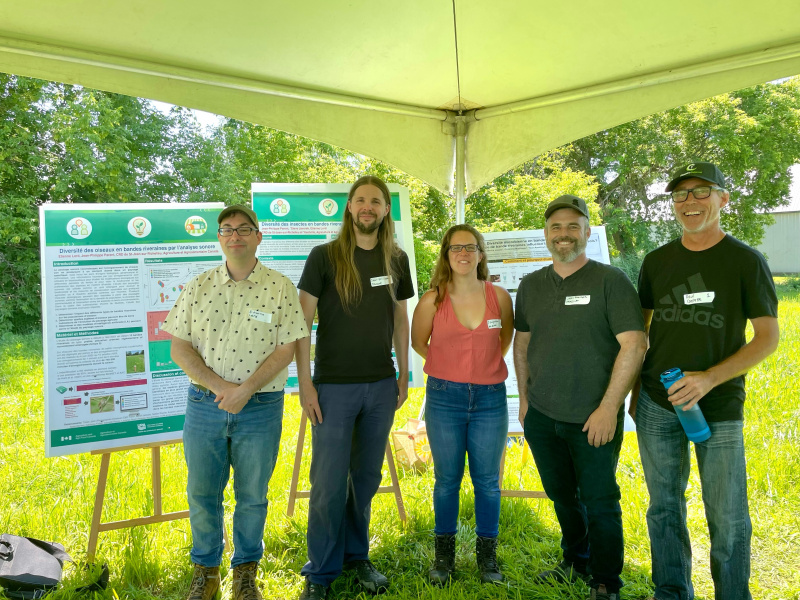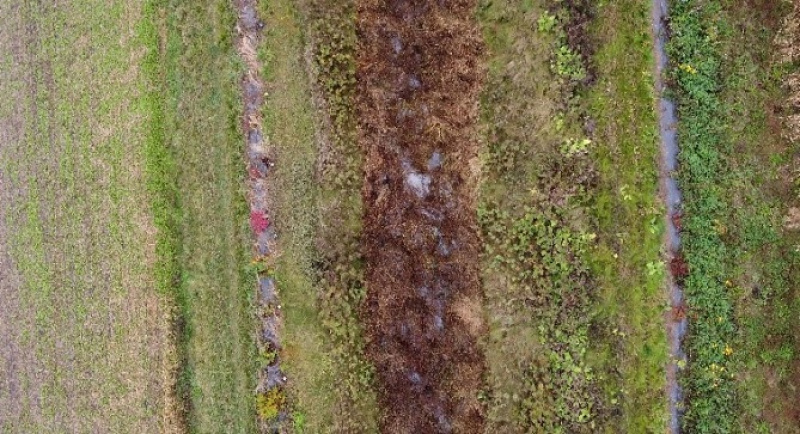Pollinators, our discreet allies
Most flowering plants depend to some degree on pollinators to reproduce. Indeed, small insects transport pollen between the male and female organs of plants allowing them to multiply. Producers of fruits, vegetables, seeds and many types of forage such as alfalfa, buckwheat, canola and clover benefit from these small insects. In Canada, the value of pollination by bees alone is estimated to be worth over $2.57 billion to the Canadian agricultural market. Even in plant varieties such as soybeans, which are not known to benefit directly from pollination, an increase in crop production yields has been recorded as a result of the presence of bees in recent scientific studies.
Although the honeybee is the first image that comes to mind, it is in fact far from being alone. Pollination is truly a team effort! In addition to the 970 species of bees native to Canada, flies are responsible for much of the pollination in this country. As part of the Living Labs Initiative, Agriculture and Agri-Food Canada (AAFC) scientists Étienne Lord and Jean-Philippe Parent are working to better understand the habitat of these species and their presence in the fields. Their work will allow producers to manage their land in a way that optimizes their yields while contributing to the conservation of biodiversity. This research is in response to concerns expressed by many agricultural stakeholders.

Scientists Etienne Lord, Jean-Philippe Parent and Jacynthe Masse as well as producers Paul Caplette and Jean-François Messier gathered at the 2022 annual meeting of Quebec – Living Lab to discuss about the ongoing research activities
“The objective of these activities is to establish the link between riparian strip designs, agricultural practices and the biodiversity of the pollinators present. We then hope to provide advice to producers on the best practices to adopt.”
- Jean-Philippe Parent, Research Scientist, AAFC
The Living Labs Initiative is a new approach to agricultural innovation in Canada. Its goal is to foster collaboration between farmers, scientists and partners to achieve environmental sustainability in agriculture.
Research on biodiversity in riparian strips is part of the Living Laboratory – Quebec, which is taking place in three watersheds in the Lac Saint-Pierre region. The project is carried out in partnership with the Union des producteurs agricoles (UPA). The project’s three priority issues are soil health, water quality and biodiversity. Rather than studying the issues separately, a holistic approach is being taken to get an overview of the situation in the field. The findings of the scientific studies and co-development activities conducted in the region will be shared with the broader Canadian agricultural community.
“As part of the Living Labs Initiative, we worked directly with producers on their land. Their knowledge of the land allowed us to quickly target suitable riparian strips for this research activity. To optimize results, we chose agricultural landscapes where the plants displayed a variety of characteristics.”
- Étienne Lord, Research Scientist, AAFC
Riparian strips, hiding places for treasures
Riparian strips, those areas of vegetation near a stream, are ideal for gaining a good understanding of pollinator population dynamics and their contribution to ecosystems. Therefore, AAFC researchers and their partners are focusing specifically on these areas for this research.
In addition to being a biodiversity refuge, these vegetated areas provide many ecological services. For example, stormwater filtration, reduced erosion and reduced pesticide runoff into streams are benefits of this type of land development.
Also, well-stocked riparian strips contribute to the beautification of our countryside. Their development has a visible impact on the plants in the vicinity. A well-stocked, colourful and flower-filled waterfront is something to be proud of in our rural areas!


Photo of a bare riparian strip in July 2022 and another photo of the same riparian strip developed in September 2022 allowing to see the changes in the flora near the stream.
“This type of project is relevant because it provides not only the UPA, but also community stakeholders with accurate data that will be used to explain and sometimes convince agricultural producers to adopt sustainable practices. The participating producers were really involved and motivated, which helped the scientists in the field. I hope that this collaboration will continue for a long time to come in order to advance the research even further.”
- Yann Bourassa, Coordinator for the watersheds on the south shore of Lac Saint-Pierre, Fédération de l’UPA du Centre-du-Québec
Measuring and recognizing biodiversity
As part of this research activity of the Living Lab – Quebec, a combination of various techniques was used to identify and count the pollinators present in these riparian strips over the past two years. The plants found there were also studied. Samples of direct captures made with insect traps as well as vegetation monitoring by drones and satellite imagery have proven to be effective, among other things.
In addition, small microphones were placed in the riparian strips around the fields to recognize birdsongs. The hours of audio recordings thus captured could then be analyzed very quickly using artificial intelligence. Otherwise, the audio sequences would have taken the researchers years to process.

Photo of an audiomoth sound sensor used to record field noise in the vicinity of the riparian strips.
These tools have identified a number of species that would have otherwise gone under the radar of researchers and producers who cannot be in the field day and night. This is a smart way to use science and technology in agriculture.
Sharing preliminary results with producers
This research validated whether certain pollinators, which are essential to many agricultural practices, including vegetable and some field crops, were present on each participating farm. Given the decline in pollinator populations worldwide, the presence of bees in riparian strips is obviously desirable. The absence of bees would justify the creation of specific habitats, such as patches of certain types of vegetation, to encourage their presence.
In fact, at the end of each year of participation in the project, the producers involved received a personalized factsheet specifying the pollinators found on their land. While some observations were self-evident, other results were much more surprising. In the good news category, some endangered pollinator species were even identified. The results will help producers determine whether new land use planning is needed to optimize their production yields and ensure environmental sustainability.
“It was mainly curiosity to learn more that led me to participate in this research project. All I had to do was give them access to my land. Now I’m looking forward to seeing the results of this research and especially to seeing the impact on my yields and harvests.”
- Michel Courchesne, agricultural producer, Coulie farm, Baie-du-Febvre
To learn more about current activities, visit the Living Laboratory - Quebec webpage.